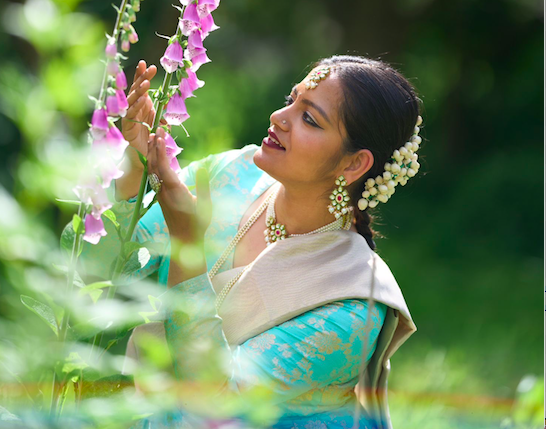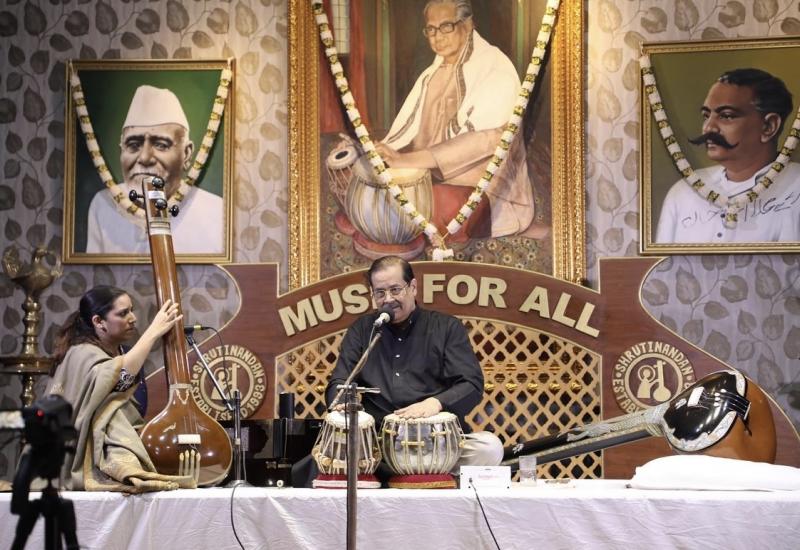Divya Sharma’s Manch Pravesh
On 14 September 2024 a milestone event will take place at the Midlands Arts Centre, Birmingham for dance student Divya Sharma and her guru Sonia Sabri. Sanjeevini Dutta spoke to both the shishya and the guru about the significance of the presentation of Divya’s Manch Pravesh.
A Manch Pravesh, ‘entry on the stage’ is a rite of passage for a dance student. When a teacher decides that their dance pupil has reached a point of proficiency when they can dance a full repertoire, usually to live music, a performance is held in front of family, friends and other invitees. It has been called ‘a marriage to your art form’, as the expectations, preparations and expenses are so demanding. The practice of presenting students in a Manch Pravesh – the term for kathak and odissi dance, or ‘Arangetram’ for bharatanatyam, divides opinions. Some are critical of the social divide that it accentuates between parents who have the financial wherewithal and those who do not; and also of potential exploitation by teachers as a money spinner. At the same time, one cannot deny the pleasure and joy it brings to the families and the benefits of the rigorous preparation to the dance student. ‘When you hear the lehra over and over again, you realise the Naad-Brahma, ‘ the sacred sound’ says Sujata Bannerji in the Banyan Tree film on dance learning.
There is no doubt that the tradition of the Manch Pravesh is alive and kicking. Prakash Yadagudde of The Bhavan in London says that he has done at least ninety arangetrams and Birmingham based Chitraleka Bolar runs a close second.
However, for Sonia Sabri the renowned kathak performer, choreographer and teacher it is a new experience. She is one of few teachers wholly trained in the UK, to be presenting for the first time a student in a Manch Pravesh on Saturday 14 September at the Midlands Arts Centre. The lucky student is twenty-eight year old Divya Sharma, a full-time dentist who lives in Newcastle and who has been a student of Sabri since the age of nine.
For Sabri the preparation is like reliving her own experience with her teacher the legendary Nahid Siddiqui. Her Manch Pravesh was also held at Midlands Arts Centre, but was then crowned by a visit to Pakistan where she was presented in the presence of Siddiqui’s guru Maharaj Ghulam Hussain in Lahore.
In continuation of her lineage from Sonia Sabri, Divya will open with a salami, a salutation in the Islamic tradition which follows a Ganesh sloka (the synthesis of Hindu and Islamic elements) and she will also dance a thumri ‘Avat Shyam’ by the late Birju Maharaj, that Sabri performed during her own Manch Pravesh. The item between the two is Hori, dedicated to Divya’s mother who always sang at festivals for family and friends. The second half of the programme will cover the technical aspects of kathak, the rhythmic play on teental, rhythmic compositions and footwork.
To whet the appetite further there is an excellent ensemble of accompanying musicians, from the highly experienced Gulfam Sabri on vocals to young Pulkit Sharma (Divya’s brother)on tabla accompaniment; Katie Stevens, flute and clarinet, Ganga Kaur on dilruba and Sonia Sabri giving the padhant (recitation).

Divya Sharma, the dancer
Divya was born in Pune, India and came to Birmingham with her parents and older brother, aged six. Her parents, father an anaesthetist and mother a writer of Hindi short stories were both keen on the arts. She describes her father’s attachment to the All India Radio app to access old Hindi and Marathi songs, whilst her mother had a vast repertoire of folk songs that she sang at festival time for family and friends, Divya was admitted to the kathak class at the Midlands Arts Centre taught by Sonia Sabri at the age of nine. At the same time Divya’s older brother Pulkit joined Sarwar Sabri’s tabla class. There was no looking back for brother and sister.
Divya reminisces ‘Me learning kathak and bhaiya learning the tabla made for a childhood full of watching kathak and tabla videos on YouTube on repeat and discussing what we saw/learnt/would like to be able to do. In fact it is something we still do this today.’
Divya names her teacher as her biggest source of inspiration. She recalls how her older brother (they are four years apart), would tease Divya that she was imitating ‘Soniaji’. Divya confides, ‘I think the little 10-year-old Divya was (and still is) just completely in awe of Sonia ji’.
As an enhancement to Divya’s training Sonia encouraged Divya to attend the summer school Dance India in Liverpool. Divya remarks that being exposed to the environment that the was full of dance and music ‘had a big impact on me. It was the closest I could get to the environment of what I imagine Kathak Kendra would be like’.
She has very fond memories of attending sessions that were led by the legendary Kumudini Lakhia and Pt Birju Maharaj. She also remembers being left ‘dumb struck’ when she saw Madhavi Mudgal and Arushi Mudgal perform odissi.
Divya’s training had to be suspended in term time, while she started a dentistry course in the Spanish city of Valencia between 2015-2020. This was the era before teaching on-line became a common practice. Over that period, Divya had to rely upon one-to-one teaching over the holidays.
When asked if Divya ever looked towards dance as a full-time profession, Divya replied that to her dance was a ‘safe-space’ to which she could turn to in turbulent times and was content to have a full time career as a dentist and to keep her dance going alongside. She hopes however that the extra stimulus of the Manch Pravesh will launch her further into teaching and performance in her chosen city of residence which is Newcastle. She is enthusiastic about the city and the surrounding countryside and coast. More opportunities to dance would certainly be a bonus after this showcase.
Watch the video
Banyan Tree Routes to Learning


















